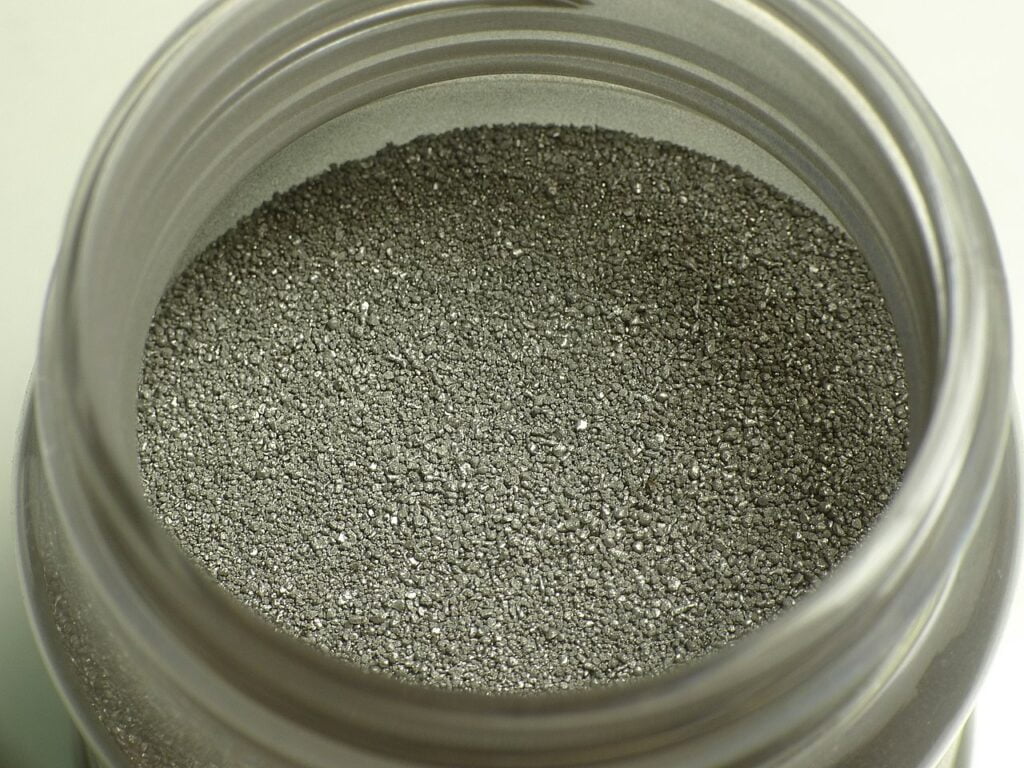粉体微粒化装置を理解する
目次
粉末噴霧 は、溶融金属から微粉末を製造するために使用される機械的プロセスである。溶融金属を微細な液滴に分解し、凝固させて粉末粒子にします。アトマイズにより、粒度分布が制御された球状の金属粉が製造されます。この概要では、粉末噴霧化装置の主要な側面について検討します。
粉末噴霧装置の種類
工業用粉体製造に使用される噴霧装置には、主にいくつかの種類がある:
| 設備 | 説明 |
|---|---|
| ガス噴霧 | 高圧不活性ガスジェットで噴霧化された溶融金属の流れ |
| 水の霧化 | 高圧ジェット水流による溶湯の分解 |
| 遠心霧化 | 回転する円盤の縁から溶融金属を流し込んだり、追い出したりする。 |
| 超音波霧化 | 溶融ストリームに高周波振動を加える |
| プラズマ霧化 | プラズマアークが金属を溶かし、微粒化する |
ガスアトマイゼーションと水アトマイゼーションは、工業的に最も一般的な方法である。遠心霧化、超音波霧化、プラズマ霧化には、より専門的な用途がある。その選択は、アトマイズされる材料、要求される粉末の仕様、生産速度、コストなどの要因によって決まる。
噴霧化プロセスの特徴
さまざまな方法による粉末噴霧化プロセスの主な特徴:
| 特徴 | 典型的な範囲 |
|---|---|
| ガス圧 | 2-8 MPa |
| 水圧 | 10-150 MPa |
| ガス流量 | 0.5~3m3/分/mm2 |
| ディスク直径 | 100-1000 mm |
| ディスク速度 | 10000-50000 rpm |
| 頻度 | 20-60 kHz |
| プラズマパワー | 30~80kW |
ガスと水の圧力が高いほど、より微細な粉末粒子が生成される。ディスク速度が速く、周波数が高いほど、より微細な粉末が得られる。この範囲は、スチール、アルミニウム、銅合金のような一般的な金属の工業的慣行を反映しています。

粉体粒子径コントロール
粒度分布はアトマイズ粉末にとって重要な品質指標である。粉体の粒子径を制御する主な要因は以下の通りです:
- 微粒化流体圧力 - より高い圧力がより微細な粒子を作る
- 微粒化流体の流量 - 流量が多いほど粒子が細かくなる
- 溶湯流量 - 溶湯流量が少ないほど粉末は細かくなる
- 微粒化ノズルの設計 - ノズル形状が液滴サイズに影響する
- ディスクとノズルの相対速度 - 相対運動が速いほど液滴は小さくなる
- 材料特性 - 粘度、表面張力は断片化に影響する
これらのパラメーターを注意深く制御することで、目標とする粒度分布を持つ粉末を製造することができる。例えば、D50が10~100ミクロンのガスアトマイズ鋼粉。
アトマイズ金属粉末の用途
アトマイズパウダーは多くの産業や用途で使用されている:
| 産業 | アプリケーション |
|---|---|
| 粉末冶金 | プレス・焼結部品、MIM原料 |
| 金属積層造形 | バインダージェット印刷、DED原料 |
| 溶射コーティング | ワイヤーアーク、プラズマ、フレームスプレーコーティング |
| 溶接 | フラックス入りアーク溶接フィラー |
| ろう付け | ブレージングペーストとプリフォーム |
| エレクトロニクス | 導電性ペーストおよびインク |
| 自動車 | 摩擦材、粉末鍛造 |
球状アトマイズパウダーは、多くの粉体処理方法に必要な優れた流動性と混合性を提供します。粉体粒度分布の厳密な制御が性能を最適化します。
粉末噴霧システム設計
霧化システムを設計する上で重要な要素は以下の通りである:
- メタル・デリバリー - タンディッシュ、注湯桶、誘導ガイドまたは回転電極
- アトマイザー - ノズルデザイン、ノズル数、ノズル配置
- 微粒化媒体 - ガス制御マニホールド、水ポンプ、配管
- パウダーコレクション - サイクロンセパレーター、バッグハウスフィルター、スクラバー
- システム制御 - 圧力、温度、流量センサーと制御ループ
さらに考慮すべきことは、封じ込め、安全インターロック、粉末の取り扱い、保管である。システムは、ほとんどの金属合金を製造するためにカスタム設計することができます。
微粒化装置の仕様
工業用ガスおよび水噴霧システムの代表的な仕様:
| パラメータ | 代表的な範囲 |
|---|---|
| 生産能力 | 10-5000 kg/h |
| 噴霧ガス圧力 | 2-8 MPa |
| 噴霧ガス流 | 0.5-3 Nm3/mm2 |
| 水圧 | 10-150 MPa |
| ノズルサイズ | 内径2-8mm |
| ノズルタイプ | ストレートボア、収束-発散 |
| サイクロン効率 | 10 μmで>95% |
| バグハウスの効率 | 1 μmで>99.9% |
容量、圧力、ノズルの詳細は、合金、希望する粒子径、生産速度によって異なります。システムは特定の用途に合わせてカスタム設計されます。
インストールと操作
粉末噴霧装置の設置および操作に関する重要な考慮事項:
- 動的機器の適切な基礎とサポート
- 構造物への振動伝達を最小限に抑える防振構造
- ガス、水道、電気系統の堅牢なインターロック
- プロセス変数のモニタリングと制御計装
- 作業ゾーンにおけるオーバースプレーと粉塵の抑制
- 煙霧・粉塵除去装置の操作
- 溶融金属の取り扱いとスプレーの安全プロトコル
- ガス/水システムの校正とメンテナンス
- 蓄積を防止するためのシャットダウンおよび清掃手順
スタートアップは、慎重に作成された手順に従うべきである。システムを安全に操作し、維持するためには、スタッフのトレーニングが重要である。
メンテナンス要件
最適な稼働時間と粉体品質のためには、定期的なメンテナンスが必要です:
- 噴霧ノズルの点検 - 磨耗または損傷したノズルを交換する。
- 遠心式噴霧器のスピンプレートを点検し、再研磨または交換する。
- 粉体回収サイクロンとバッグハウスフィルターの清掃
- 圧力、流量、温度センサーの校正の確認
- 緊急停止バルブとインターロックの動作をチェックする。
- 霧化ガスの純度を監視する-水分は酸化を引き起こす可能性がある
- 供給ラインとタンディッシュを清掃し、金属の蓄積を防ぐ
- スピンドライブモーターとベアリングの潤滑と点検
稼働時間と重要性に基づいて、メンテナンスのスケジュールと手順を確立する。
霧化装置サプライヤーの選択
霧化システム・サプライヤーを選択する際の主な要因:
- アトマイズされる特定の合金に関する経験
- フルシステムのエンジニアリング能力
- 利用可能なノズルデザインとアトマイザー構成の範囲
- 容量と粒子径のニーズに柔軟に対応
- 設置、トレーニング、アフターセールス・サポートを提供
- 対象市場における現地プレゼンスまたはパートナーシップ
- 適用される規範および基準の遵守
- 類似プロジェクトの参考文献とケーススタディ
- 価格と納期
機器のコストだけでなく、技術的な専門知識に基づいてサプライヤーを評価する。経験豊富なパートナーが成功を確実にします。

噴霧化システムのコスト分析
アトマイズ装置は資本コストが高いが、競争力のある価格で粉末を生産できる:
| システム | 資本コストの範囲 | パウダー価格帯 |
|---|---|---|
| ガス噴霧 | $500,000 – $5,000,000 | $5-50/キロ |
| 水の霧化 | $200,000 – $2,000,000 | $2-20/キロ |
| 遠心霧化 | $50,000 – $500,000 | $10-100/kg |
| 超音波霧化 | $100,000 – $1,000,000 | $50-500/kg |
| プラズマ霧化 | $200,000 – $2,000,000 | $20-200/kg |
生産能力、構造材料、制御装置によって決まるコスト。ファインパウダーはプレミアム価格。設備投資を正当化するためには高い生産量が必要。
粉末噴霧法の長所と短所
様々な霧化技術の利点と限界の比較:
| 方法 | メリット | デメリット |
|---|---|---|
| ガス噴霧 | 最も狭い粒子分布、不活性雰囲気 | 資本コストが高く、ガス消費量が多い |
| 水の霧化 | 低設備コスト、小粒径 | 酸化の可能性あり、乾燥が必要 |
| 遠心霧化 | シンプルな設計でスケールアップが容易 | 幅広い粒子分布、不規則な形状 |
| 超音波霧化 | 液体不要、ローメンテナンス | 限られた合金と生産量 |
| プラズマ霧化 | 純金属の非常に微細な粒子 | 高エネルギー使用、低粉体出力 |
粒子径、雰囲気、コスト、合金適合性などの優先要素に基づいて方法を選択する。すべてのシナリオに対応できる最良の選択肢はない。
粉体噴霧技術の要点
- 溶融合金から微細金属粉末を製造するための幅広い装置オプション
- ガスと水の霧化が最も一般的。
- 流体と金属の流動力学の制御が最終的な粒子径を支配する
- 粒子分布を最適化した球状パウダーが高度なアプリケーションを可能にする
- 多額の設備投資が必要だが、パウダー価格なら対応可能
- 噴霧化プロジェクトの成功には経験豊富なサプライヤーとの提携が不可欠
入念なプロセス開発とエンジニアリングにより、用途のニーズに合った特性を持つパウダーが製造される。
粉末噴霧化装置に関するFAQ
Q: どのような金属や合金をアトマイズして粉末にできますか?
A: ほとんどの標準鋼、アルミニウム合金、銅合金、ニッケル超合金のアトマイズが可能です。タングステンやタンタルのような耐火金属も可能です。融点、反応性、粘度によって制限があります。
Q: 一般的なガス噴霧の圧力と流量は?
A: ガス圧力は、空気または窒素やアルゴンなどの不活性ガスで2~8MPaです。流量はノズル開口面積0.5~3Nm3/min/mm2で、圧力や対象粒子径によって異なります。
Q:微粒化によって粒子はどれくらい小さくできますか?
A: ガスや水による霧化では、5~10ミクロンまでの粉体を作ることができます。超音波やプラズマのような特殊な技術では、サブミクロンの粒子を生成することができます。サイズが小さいと、生産率はかなり低くなります。
Q: 粒度分布はどの程度安定していますか?
A: うまく設計された微粒化システムは、通常の粒度分布で5-10%のCVを達成できます。より厳しい粒度分布も可能ですが、広範なプロセス開発と制御が必要です。
Q:遠心霧化法ではどれくらいの量の粉体を生産できますか?
A: 遠心噴霧器は比較的コンパクトで低コストです。生産能力は10-100kg/hで、少量の特殊合金に適しています。
Q: 噴霧システムの資本コストは何で決まりますか?
A: 主な要因は、処理する合金、目標とする粒子径と分布、生産速度、制御、および構造材料です。500kg/hのガスアトマイズシステムは約$1-200万円です。
Q: 粉末噴霧にはどのような安全上の注意が必要ですか?
A: 高温の金属や噴霧された粉体を取り扱う際には、適切な個人用保護具を着用することが重要です。オーバースプレーの封じ込め、適切な換気、ガスや粉塵の監視装置、緊急停止回路はリスクを軽減するのに役立ちます。
Q: 噴霧装置にはどのようなメンテナンスが必要ですか?
A: ノズル、スピンプレート、回収サイクロンは経年劣化するため、交換が必要です。ホース、バルブ、センサー、ポンプは定期的に点検する必要があります。適切なスタートアップとシャットダウンは、蓄積を防ぐ。プロトコルに関するスタッフのトレーニングは不可欠である。
Q: 噴霧化後の粉体の取り扱いや保管はどのように管理されていますか?
A: 粉末は、曝露と酸化を抑えるために、コレクターから密閉容器に素早く移すべきである。水分管理が重要である。防火・防爆ベント付きの独立した室温保管が標準である。
Q: 噴霧システムの設計にはどのような基準が適用されますか?
A: 普遍的な規格はありませんが、適用される圧力容器規格と材料規格が設計の選択肢を決定します。地域の規制や要件に精通した経験豊富なサプライヤーに相談してください。新しい危険なシステムを設置する際には、法律や規制の協議を受けてください。
シェアする
MET3DP Technology Co., LTDは、中国青島に本社を置く積層造形ソリューションのリーディングプロバイダーです。弊社は3Dプリンティング装置と工業用途の高性能金属粉末を専門としています。
関連記事
Met3DPについて
最新情報
製品

3Dプリンティングと積層造形用金属粉末









